Roles of Climate Change and Increasing CO2 in Driving Changes of Net Primary Productivity in China Simulated Using a Dynamic Global Vegetation Model
Abstract
1. Introduction
2. Materials and Methods
2.1. LPJ Model
2.2. Input Data
2.3. Modelling Protocol
3. Results and Discussion
3.1. Temporal Trends of Terrestrial NPP in China and Linkage with ENSO
3.2. Spatial Pattern of Terrestrial NPP in China
3.3. Comparison with Previous Studies
3.4. Changes of NPP in the Future
3.5. Influence of Future CO2 Increase and Climate Change on NPP
4. Conclusions
- (1)
- Total NPP of China’s terrestrial ecosystem increased from 2.8 to 3.6 Pg C yr−1 over the period of 1961–2016, with an annual average of 3.1 Pg C yr−1. Southwest China acted as the largest contributor to national total NPP among the six geographical regions of China, while Northwest China played the smallest role. Total NPP exhibited gradually increasing trends in Northwest China, Southwest China, South-central China, and East China.
- (2)
- National total NPP exhibited large interannual variability. NPP anomalies in China’s terrestrial ecosystems were strongly associated with the El Niño-Southern Oscillation (ENSO). Overall, the national total of NPP declined remarkably in the EP EI Niño year while increasing in the CP EI Niño year. The national total NPP often increased in the La Niña year. However, continuous La Niña events might induce NPP to decrease. Southwest China made the largest contribution to the interannual variability of national total NPP, the next is South-central China.
- (3)
- The total NPP in the A2 and RCP85 scenarios would be obviously larger than those in the B1 and RCP45 scenarios. During the period from 2091 to 2100, the average total NPP under the A2 and RCP85 scenarios would reach 4.9 and 5.1 Pg C yr−1 respectively, higher than 4.2 and 3.9 Pg C yr−1 under the B1 and RCP45 scenarios. The future increase of NPP in China would be dominantly contributed to by the fertilization effect of CO2, while the climate change would have slightly negative effects on NPP.
Author Contributions
Funding
Acknowledgments
Conflicts of Interest
References
- Joos, F.; Spahni, R. Rates of change in natural and anthropogenic radiative forcing over the past 20,000 years. Proc. Natl. Acad. Sci. USA 2008, 105, 1425–1430. [Google Scholar] [CrossRef]
- Le Quéré, C.; Andrew, R.M.; Friedlingstein, P.; Sitch, S.; Hauck, J.; Pongratz, J.; Pickers, P.A.; Korsbakken, J.I.; Peters, G.P.; Canadell, J.G.; et al. Global carbon budget 2018. Earth Syst. Sci. Data. 2018, 10, 2141–2194. [Google Scholar] [CrossRef]
- Haberl, H.; Erb, K.-H.; Krausmann, F. Human Appropriation of Net Primary Production: Patterns, Trends, and Planetary Boundaries. Annu. Rev. Environ. Resour. 2014, 39, 363–391. [Google Scholar] [CrossRef]
- Zhang, F.; Pu, L.; Huang, Q. Quantitative assessment of the human appropriation of net primary production (HANPP) in the coastal areas of Jiangsu, China. Sustainability. 2015, 7, 15857–15870. [Google Scholar] [CrossRef]
- Waring, R.H.; Coops, N.C.; Ohmann, J.L. Interpreting woody plant richness from seasonal ratios of photosynthesis. Ecology. 2002, 83, 2964–2970. [Google Scholar] [CrossRef]
- Running, S.W.; Nemani, R.R.; Heinsch, F.A. A continuous satellite-derived measure of global terrestrial primary production. Bioscience. 2004, 54, 547–560. [Google Scholar] [CrossRef]
- Ito, A. A historical meta-analysis of global terrestrial net primary productivity: Are estimates converging? Glob. Chang. Boil. 2011, 17, 3161–3175. [Google Scholar] [CrossRef]
- Sarmiento, J.L.; Gloor, M.; Gruber, N. Trends and regional distributions of land and ocean carbon sinks. Biogeosciences. 2010, 7, 2351–2367. [Google Scholar] [CrossRef]
- Ahlström, A.; Raupach, M.R.; Schurgers, G.; Smith, B.; Arneth, A.; Jung, M.; Reichstein, M.; Canadell, J.G.; Friedlingstein, P.; Jain, A.K.; et al. The dominant role of semi-arid ecosystems in the trend and variability of the land CO2 sink. Science 2015, 348, 895–899. [Google Scholar] [CrossRef]
- Piao, S.; Huang, M.; Liu, Z.; Wang, X.; Ciais, P.; Canadell, J.G.; Wang, K.; Bastos, A.; Friedlingstein, P.; Houghton, R.A.; et al. Lower land-use emissions responsible for increased net land carbon sink during the slow warming period. Nat. Geosci. 2018, 11, 739–743. [Google Scholar] [CrossRef]
- Piao, S.L.; Ciais, P.; Lomas, M.; Beer, C.; Liu, H.; Fang, J.; Friedlingstein, P.; Huang, Y.; Muraoka, H.; Son, Y.; et al. Contribution of climate change and rising CO2 to terrestrial carbon balance in East Asia: A multi-model analysis. Glob. Planet. Chang. 2011, 75, 133–142. [Google Scholar] [CrossRef]
- Fang, J.Y.; Yu, G.; Liu, L.; Hu, S.; Chapin, F.S., III. Climate change, human impacts, and carbon sequestration in China. Proc. Natl. Acad. Sci. USA 2018, 115, 4015–4020. [Google Scholar] [CrossRef]
- Wang, Q.; Zheng, H.; Zhu, X.; Yu, G. Primary estimation of Chinese terrestrial carbon sequestration during 2001–2010. Sci. Bull. 2015, 60, 577–590. [Google Scholar] [CrossRef]
- Fang, J.Y.; Piao, S.L.; Field, C.B.; Pan, Y.; Guo, Q.; Zhou, L.; Peng, C.; Tao, S. Increasing Net Primary Production in China from 1982 to 1999. Front. Ecol. Environ. 2003, 1, 293. [Google Scholar] [CrossRef]
- Piao, S.L.; Fang, J.Y.; Guo, Q.H. Application of CASA model to the estimation of Chinese terrestrial net primary productivity. Chin. J. Plant Ecol. 2001, 25, 603–608. (In Chinese) [Google Scholar]
- Piao, S.L.; Fang, J.Y.; Guo, Q.H. Terrestrial net primary production and its spatio-temporal patterns in China during 1982–1999. Acta Sci. Nat. Univ. Pekin. 2001, 37, 563–569. (In Chinese) [Google Scholar]
- Sun, R.; Zhu, Q.J. Distribution and seasonal change of net primary productivity in China from April, 1992 to March, 1993. Acta Geogr. Sin. 2000, 55, 36–45. (In Chinese) [Google Scholar]
- Li, J.; Wang, Z.; Lai, C.; Wu, X.; Zeng, Z.; Chen, X.; Lian, Y. Response of net primary production to land use and land cover change in mainland China since the late 1980s. Sci. Total Environ. 2018, 639, 237–247. [Google Scholar] [CrossRef]
- Cao, M.K.; Prince, S.D.; Li, K.R.; Tao, B.; Small, J.; Shao, X. Response of terrestrial carbon uptake to climate interannual variability in China. Glob. Chang. Biol. 2003, 9, 536–546. [Google Scholar] [CrossRef]
- Liang, M.L.; Xie, Z.H. Simulations of Climate Effects on Vegetation Distribution and Net Primary Production in China. Clim. Environ. Res. 2006, 11, 582–592. (In Chinese) [Google Scholar]
- Feng, X.F.; Liu, G.; Chen, J.M.; Chen, M.; Liu, J.; Ju, W.M.; Sun, R.; Zhou, W. Net primary productivity of China’s terrestrial ecosystems from a process model driven by remote sensing. J. Environ. Manag. 2007, 85, 563–573. [Google Scholar] [CrossRef]
- Ju, W.M.; Chen, J.M.; Harvey, D.; Wang, S. Future carbon balance of China’s forests under climate change and increasing CO2. J. Environ. Manag. 2007, 85, 538–562. [Google Scholar] [CrossRef]
- Tao, F.; Zhang, Z. Dynamic responses of terrestrial ecosystems structure and function to climate change in China. J. Geophys. Res. Space Phys. 2010, 115. [Google Scholar] [CrossRef]
- Liu, Y.B.; Ju, W.M.; He, H.L.; Wang, S.; Sun, R.; Zhang, Y. Changes of net primary productivity in China during recent 11 years detected using an ecological model driven by MODIS data. Front. Earth Sci. 2013, 7, 112–127. [Google Scholar] [CrossRef]
- Pei, F.; Li, X.; Liu, X.; Lao, C. Assessing the impacts of droughts on net primary productivity in China. J. Environ. Manag. 2013, 114, 362–371. [Google Scholar] [CrossRef]
- Yang, Y.Z.; Ma, Y.D.; Jiang, H. Evaluating the carbon budget pattern of Chinese terrestrial ecosystem from 1960 to 2006 using Integrated Biosphere Simulator. Acta Ecol. Sin. 2016, 36, 3911–3922. (In Chinese) [Google Scholar]
- Shao, Q.; Huang, L.; Liu, J.; Kuang, W.; Li, J. Analysis of forest damage caused by the snow and ice chaos along a transect across southern China in spring 2008. J. Geogr. Sci. 2011, 21, 219–234. [Google Scholar] [CrossRef]
- Lu, E.; Luo, Y.; Zhang, R.; Wu, Q.; Liu, L. Regional atmospheric anomalies responsible for the 2009–2010 severe drought in China. J. Geophys. Res. Space Phys. 2011, 116, 21114. [Google Scholar] [CrossRef]
- Bi, B.G.; Zhang, X.L.; Dai, K. Characteristics of 2016 severe convective weather and extreme rainfalls under the background of super El Niño. Chin. Sci. Bull. 2017, 62, 928–937. (In Chinese) [Google Scholar] [CrossRef]
- Wolter, K.; Timlin, M.S. El Niño/Southern Oscillation behaviour since 1871 as diagnosed in an extended multivariate ENSO index (MEI.ext). Int. J. Clim. 2011, 31, 1074–1087. [Google Scholar] [CrossRef]
- Behrenfeld, M.J.; Randerson, J.T.; Mcclain, C.R.; Feldman, G.C.; Los, S.O.; Tucker, C.J.; Falkowski, P.G.; Field, C.B.; Frouin, R.; Esaias, W.E.; et al. Biospheric Primary Production During an ENSO Transition. Science 2001, 291, 2594–2597. [Google Scholar] [CrossRef]
- Nemani, R.R.; Keeling, C.D.; Hashimoto, H. Climate-driven increases in global terrestrial net primary production from 1982 to 1999. Science 2003, 300, 1560–1563. [Google Scholar] [CrossRef]
- Bastos, A.; Gouveia, C.; Trigo, R.M.; Running, S.W. The global NPP dependence on ENSO: La Niña and the extraordinary year of 2011. J. Geophys. Res. Biogeosci. 2013, 118, 1247–1255. [Google Scholar] [CrossRef]
- Poulter, B.; Frank, D.; Ciais, P.; Myneni, R.B.; Andela, N.; Bi, J.; Broquet, G.; Canadell, J.G.; Chevallier, F.; Liu, Y.Y.; et al. Contribution of semi-arid ecosystems to interannual variability of the global carbon cycle. Nature. 2014, 509, 600–603. [Google Scholar] [CrossRef]
- Nowak, R.S.; Ellsworth, D.S.; Smith, S.D. Functional responses of plants to elevated atmospheric CO2–do photosynthetic and productivity data from FACE experiments support early predictions? New Phytol. 2004, 162, 253–280. [Google Scholar] [CrossRef]
- Reich, P.B.; Hobbie, S.E.; Lee, T.D. Plant growth enhancement by elevated CO2 eliminated by joint water and nitrogen limitation. Nat. Geosci. 2014, 7, 920. [Google Scholar] [CrossRef]
- Smith, W.K.; Reed, S.C.; Cleveland, C.C. Large divergence of satellite and Earth system model estimates of global terrestrial CO2 fertilization. Nat. Clim. Chang. 2016, 6, 306. [Google Scholar] [CrossRef]
- Hovenden, M.J.; Leuzinger, S.; Newton, P.C.D.; Fletcher, A.; Fatichi, S.; Lüscher, A.; Reich, P.B.; Andresen, L.C.; Beier, C.; Blumenthal, D.M.; et al. Globally consistent influences of seasonal precipitation limit grassland biomass response to elevated CO2. Nat. Plants. 2019, 5, 167. [Google Scholar] [CrossRef]
- Chen, J.M.; Ju, W.M.; Liu, R.G. Calculation and Optimization Methods of Global Terrestrial Carbon Sink Based on Remote Sensing; Science Press: Beijing, China, 2015; pp. 162–164. (In Chinese) [Google Scholar]
- Prentice, I.C.; Cramer, W.; Harrison, S.P.; Leemans, R.; Monserud, R.A.; Solomon, A.M. Special paper: A global biome model based on plant physiology and dominance, soil properties and climate. J. Biogeogr. 1992, 19, 117–134. [Google Scholar] [CrossRef]
- Haxeltine, A.; Prentice, I.C. BIOME3: An equilibrium terrestrial biosphere model based on ecophysiological constraints, resource availability, and competition among plant functional types. Glob. Biogeochem. Cycles. 1996, 10, 693–709. [Google Scholar] [CrossRef]
- Sitch, S.; Smith, B.; Prentice, I.C.; Arneth, A.; Bondeau, A.; Cramer, W.; Kaplan, J.; Levis, S.; Lucht, W.; Sykes, M.T.; et al. Evaluation of ecosystem dynamics, plant geography and terrestrial carbon cycling in the LPJ dynamic global vegetation model. Glob. Chang. Boil. 2003, 9, 161–185. [Google Scholar] [CrossRef]
- Gerten, D.; Schaphoff, S.; Haberlandt, U.; Lucht, W.; Sitch, S. Terrestrial vegetation and water balance—Hydrological evaluation of a dynamic global vegetation model. J. Hydrol. 2004, 286, 249–270. [Google Scholar] [CrossRef]
- Rost, S.; Gerten, D.; Bondeau, A.; Lucht, W.; Rohwer, J.; Schaphoff, S. Agricultural green and blue water consumption and its influence on the global water system. Water Resour. Res. 2008, 44. [Google Scholar] [CrossRef]
- Fader, M.; Rost, S.; Muller, C.; Bondeau, A.; Gerten, D. Virtual water content of temperate cereals and maize: Present and potential future patterns. J. Hydrol. 2010, 384, 218–231. [Google Scholar] [CrossRef]
- Müller, C.; Robertson, R.D. Projecting future crop productivity for global economic modeling. Agric. Econ. 2014, 45, 37–50. [Google Scholar] [CrossRef]
- Beringer, T.; Lucht, W.; Schaphoff, S. Bioenergy production potential of global biomass plantations under environmental and agricultural constraints. Gcb Bioenergy 2011, 3, 299–312. [Google Scholar] [CrossRef]
- Schaphoff, S.; Heyder, U.; Ostberg, S.; Gerten, D.; Heinke, J.; Lucht, W. Contribution of permafrost soils to the global carbon budget. Environ. Res. Lett. 2013, 8, 014026. [Google Scholar] [CrossRef]
- Thonicke, K.; Spessa, A.; Prentice, I.C.; Harrison, S.P.; Dong, L.; Carmona-Moreno, C. The influence of vegetation, fire spread and fire behaviour on biomass burning and trace gas emissions: Results from a process-based model. Biogeosciences 2010, 7, 1991–2011. [Google Scholar] [CrossRef]
- Bloh, W.; Schaphoff, S.; Müller, C.; Rolinski, S.; Waha, K.; Zaehle, S. Implementing the nitrogen cycle into the dynamic global vegetation, hydrology, and crop growth model LPJmL (version 5.0). Geosci. Model Dev. 2018, 11, 2789–2812. [Google Scholar] [CrossRef]
- Harris, I.; Jones, P.D.; Osborn, T.J.; Lister, D.H. Updated high-resolution grids of monthly climatic observations–the CRU TS3. 10 Dataset. Int. J. Climatol. 2014, 34, 623–642. [Google Scholar] [CrossRef]
- Mitchell, T.D.; Jones, P.D. An improved method of constructing a database of monthly climate observations and associated high-resolution grids. Int. J. Climatol. 2005, 25, 693–712. [Google Scholar] [CrossRef]
- McGuire, A.D.; Sitch, S.; Clein, J.S. Carbon balance of the terrestrial biosphere in the twentieth century: Analyses of CO2, climate and land use effects with four process-based ecosystem models. Glob. Biogeochem. Cycles. 2001, 15, 183–206. [Google Scholar] [CrossRef]
- Kichlighter, D.W.; Bruno, M.; Donges, S. A first-order analysis of the potential role of the potential role of CO2 fertilization to affect the global carbon budget: A comparison of four terrestrial biosphere models. Tellus B 1999, 51, 343–366. [Google Scholar]
- Zöbler, L. A World Soil File for Global Climate Modelling; NASA Technical Memorandum; National Aeronautics and Space Administration, Goddard Space Flight Center, Institute for Space Studies: Washington, DC, USA, 1986.
- FAO. The Digitized Soil Map of the World (Release 1.0); Food and Agriculture Organization: Rome, Italy, 1991. [Google Scholar]
- Deb, P.; Debnath, P.; Denis, A.F.; Lepcha, O.T. Variability of soil physicochemical properties at different agroecological zones of Himalayan region: Sikkim, India. Environ. Dev. Sustain. 2018, 1–19. [Google Scholar] [CrossRef]
- Van Vuuren, D.P.; Edmonds, J.; Kainuma, M. The representative concentration pathways: An overview. Clim. Chang. 2011, 109, 5. [Google Scholar] [CrossRef]
- Jin, Z.H.; Tao, S.Y. A Study on the Relationships between ENSO Cycle and Rainfalls during summer and winter in Eastern China. Chin. J. Atmos. Sci. 1999, 23, 663–672. (In Chinese) [Google Scholar]
- Zhang, L.P.; Zhang, L.F. The relationships between ENSO and JJA rainfull over the east of China. J. Trop. Meteorol. 2012, 28, 177–186. (In Chinese) [Google Scholar]
- Fan, L.L.; Xu, F.; Xu, H. Spring and summer El Niño events and their influences on summer precipitation in China. Trans. Atmos. Sci. 2018, 41, 101–110. (In Chinese) [Google Scholar]
- Tao, B.; Li, K.; Shao, X. The temporal and spatial patterns of terrestrial net primary productivity in China. J. Geogr. Sci. 2003, 13, 163–171. (In Chinese) [Google Scholar]
- Timlin, M.S.; Wolter, K. Measuring the strength of ENSO events: How does 1997/98 rank? Weather 1998, 53, 315–324. [Google Scholar]
- Zhu, W.Q.; Pan, Y.Z.; Zhang, J.S. Estimation of net primary productivity of Chinese terrestrial vegetation based on remote sensing. Acta Phytoecol. Sin. 2007, 31, 413–424. (In Chinese) [Google Scholar]
- Gao, Y.N.; Yu, G.R.; Zhang, L.; Liu, M.; Huang, M.; Wang, Q. The changes of net primary productivity in Chinese terrestrial ecosystem: Based on process and parameter models. Prog Geogr. 2012, 31, 109–117. (In Chinese) [Google Scholar]
- Xiao, X.M.; Melillo, J.; Kicklighter, D.W.; Pan, Y. Net primary production of terrestrial ecosystems in China and its equilibrium response to changes in climate and atmospheric CO2 concentration. Acta Phytoecol. Sin. 1998, 22, 97–118. [Google Scholar]
- Gao, Z.Q.; Liu, J.Y. Simulation study of China’s net primary production. Chin. Sci. Bull. 2008, 53, 434–443. [Google Scholar] [CrossRef]
- Ji, J.J.; Huang, M.; Li, K.R. Prediction of carbon exchanges between China terrestrial ecosystem and atmosphere in 21st century. Sci. China. 2008, 51, 211–223. (In Chinese) [Google Scholar] [CrossRef]
- Sun, G.D. Simulation of potential vegetation distribution and estimation of carbon flux in China from 1981 to 1998 with LPJ dynamic global vegetation model. Clim. Environ. Res. 2009, 14, 341–351. (In Chinese) [Google Scholar]
- Baldocchi, D.; Falge, E.; Gu, L.; Olson, R.; Hollinger, D.; Running, S.; Anthoni, P.; Bernhofer, C.; Davis, K.; Evans, R.; et al. FLUXNET: A New Tool to Study the Temporal and Spatial Variability of Ecosystem–Scale Carbon Dioxide, Water Vapor, and Energy Flux Densities. Bull. Am. Meteorol. Soc. 2001, 82, 2415–2434. [Google Scholar] [CrossRef]
- Yu, G.R.; Zhu, X.J.; Fu, Y.L.; He, H.L.; Wang, Q.F.; Wen, X.F.; Li, X.R.; Zhang, L.M.; Zhang, L.; Su, W.; et al. Spatial patterns and climate drivers of carbon fluxes in terrestrial ecosystems of China. Glob. Chang. Boil. 2013, 19, 798–810. [Google Scholar] [CrossRef]
- Xiao, J.; Sun, G.; Chen, J. Carbon fluxes, evapotranspiration, and water use efficiency of terrestrial ecosystems in China. Agric. For. Meteorol. 2013, 182, 76–90. [Google Scholar] [CrossRef]
- Blue Book on Climate Change of China (2018); China Meteorological Administration Climate Change Center: Beijing, China, 2018. (In Chinese)
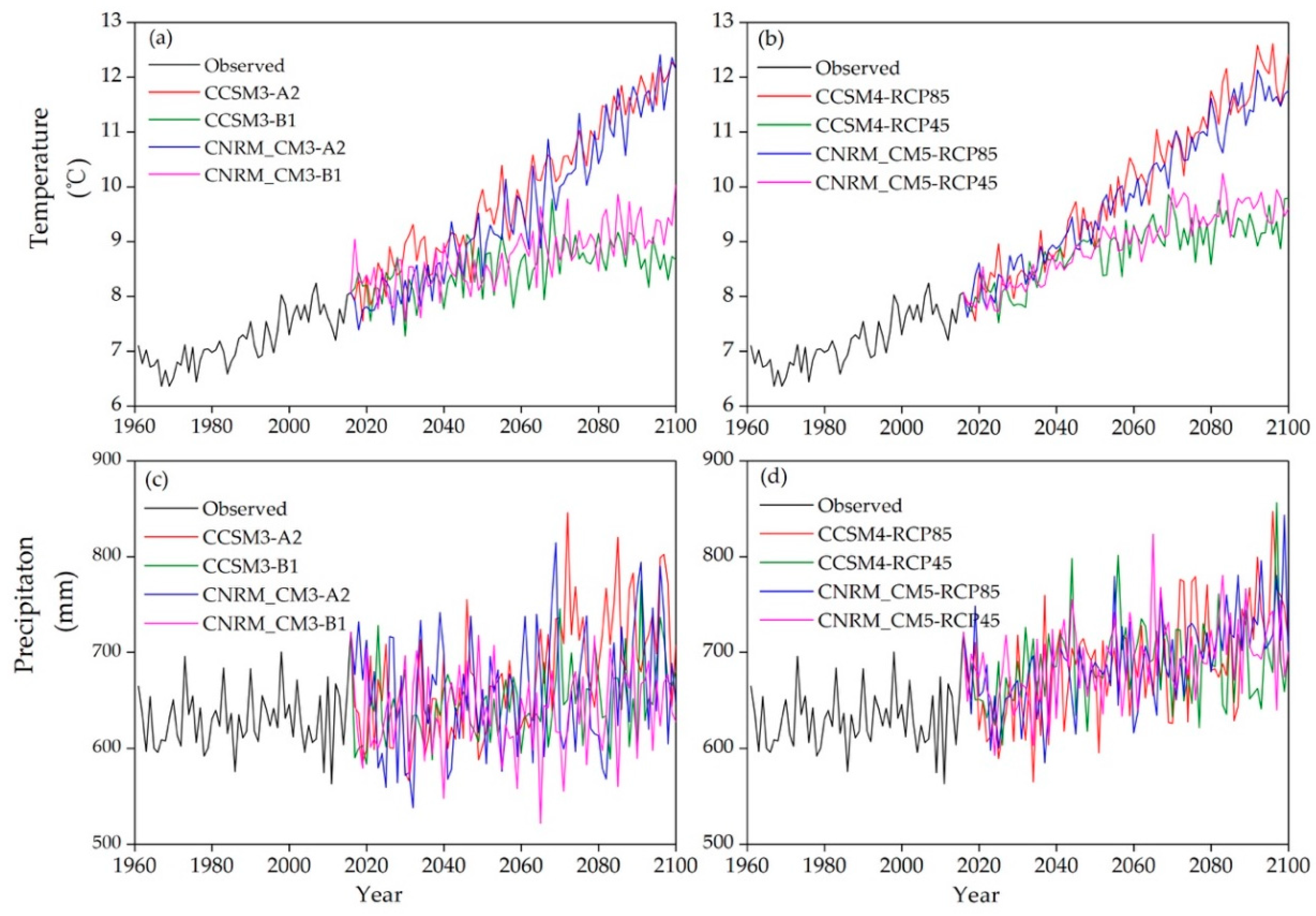
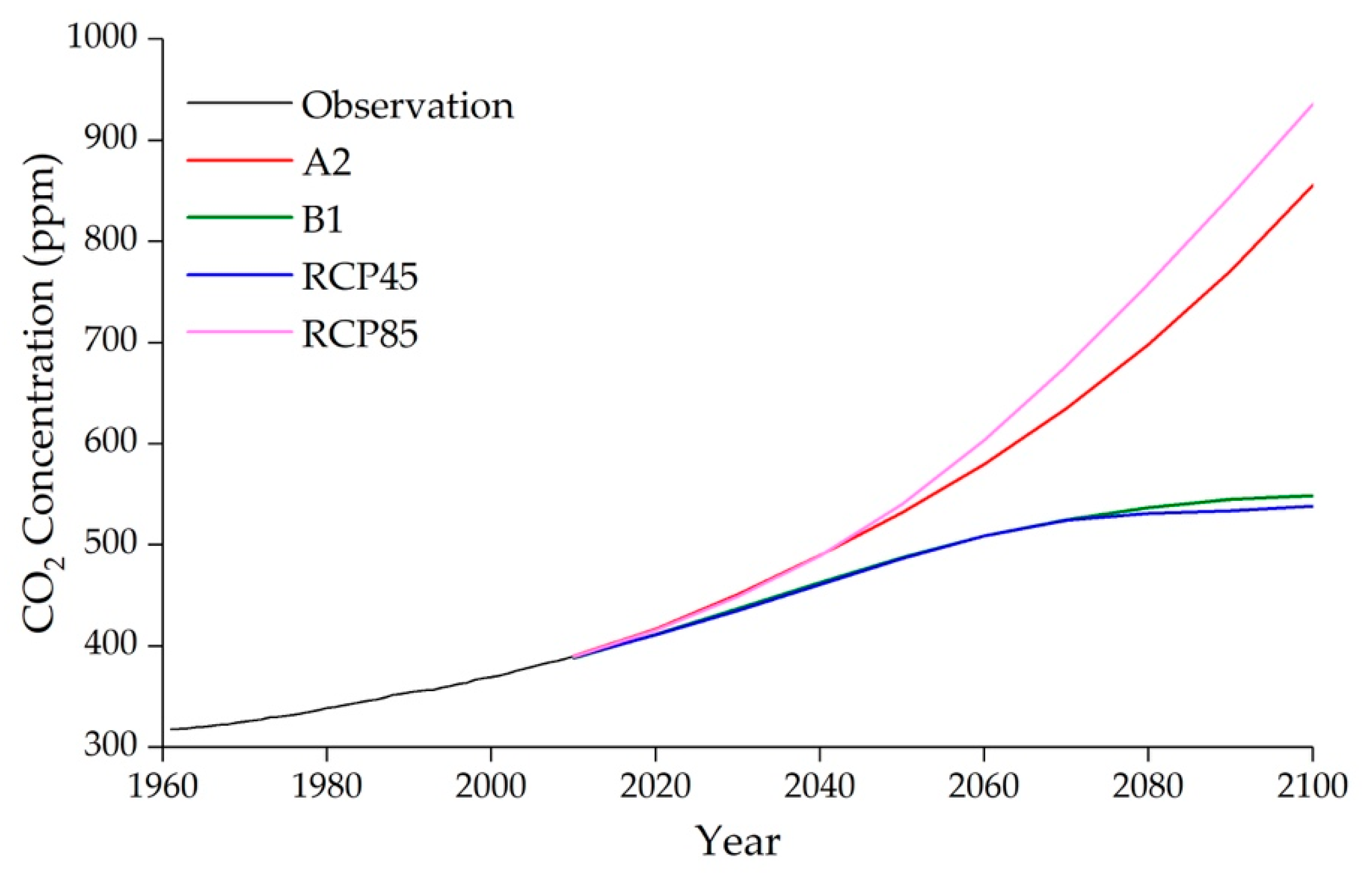
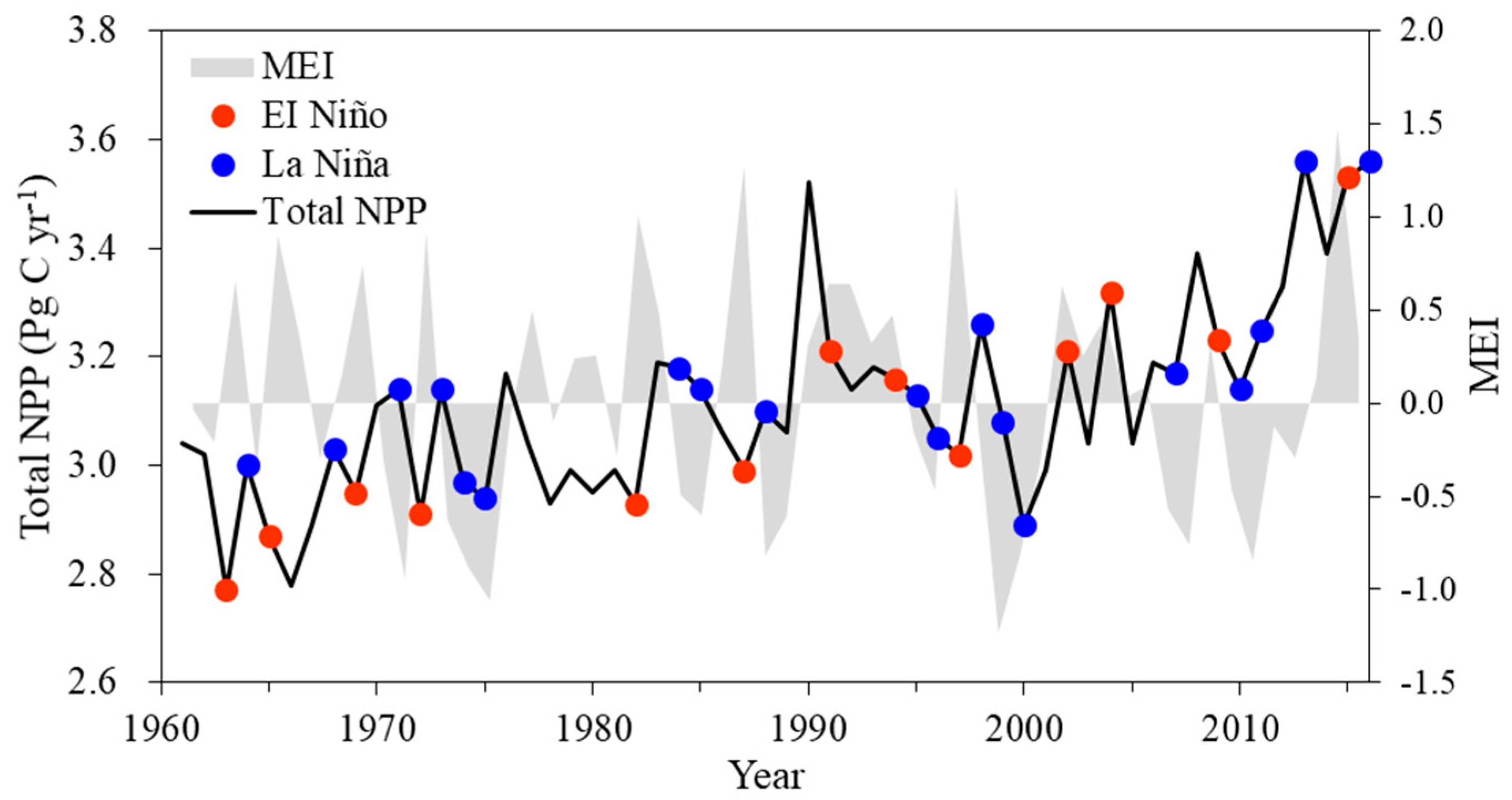

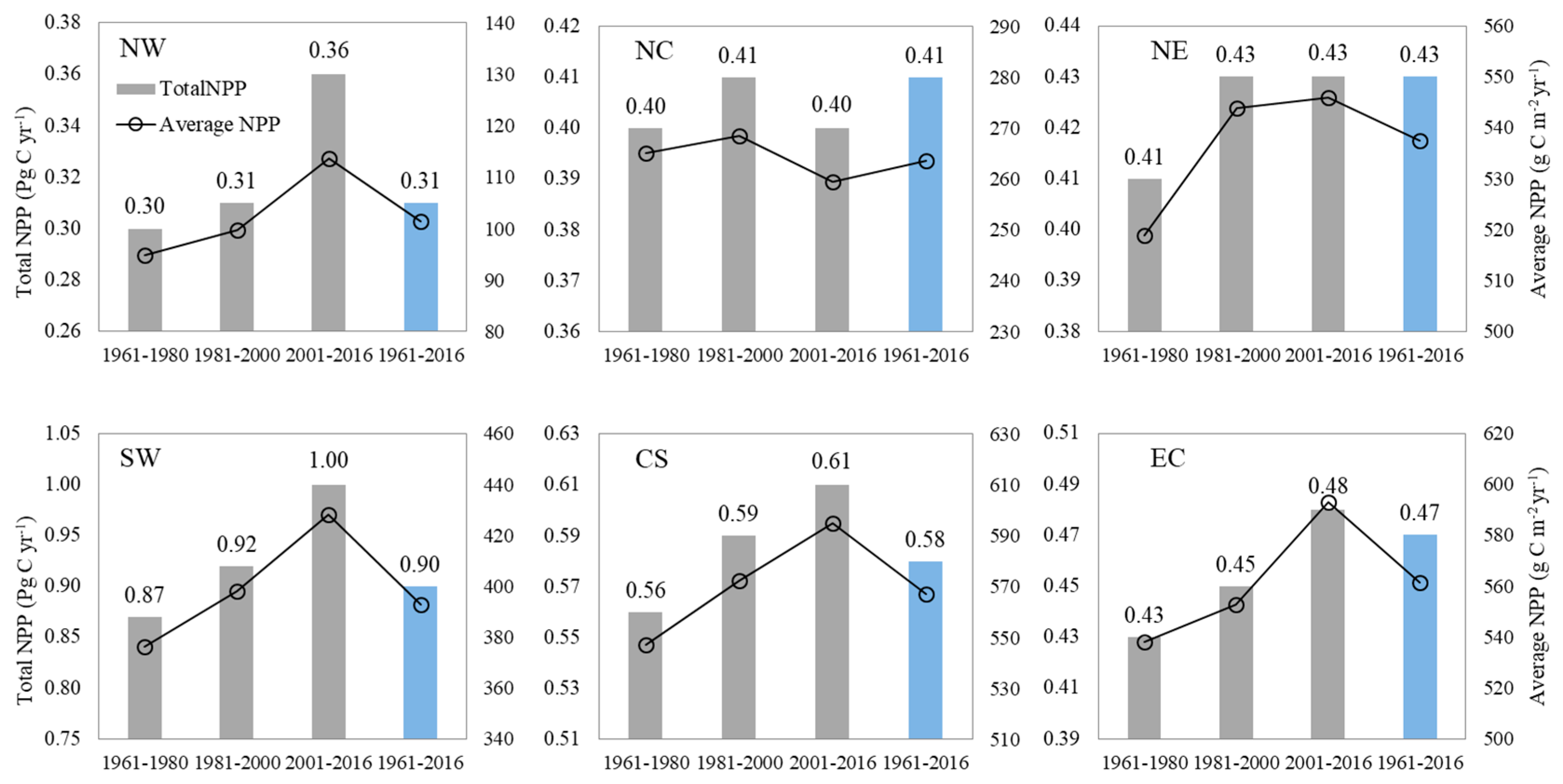
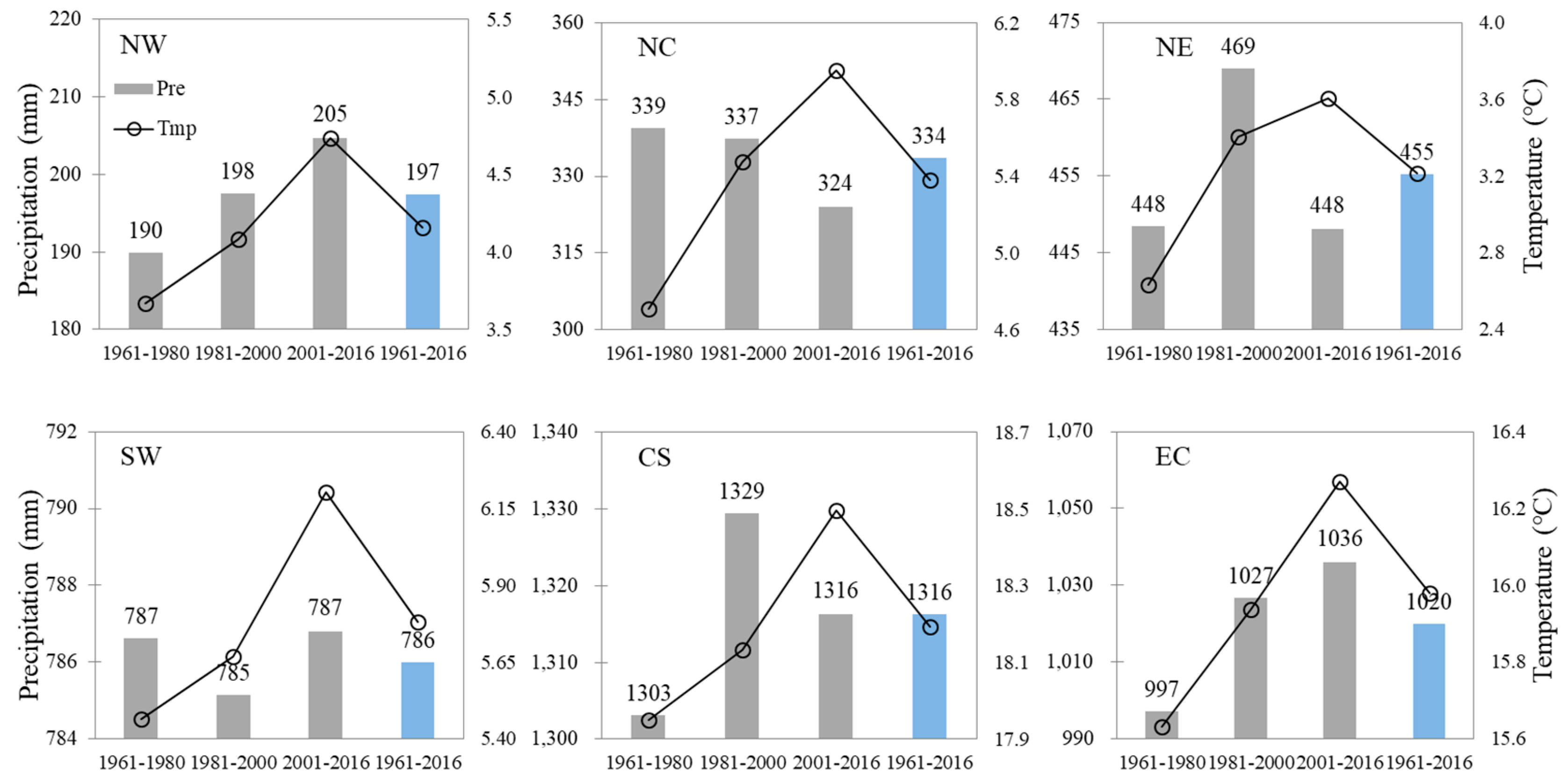
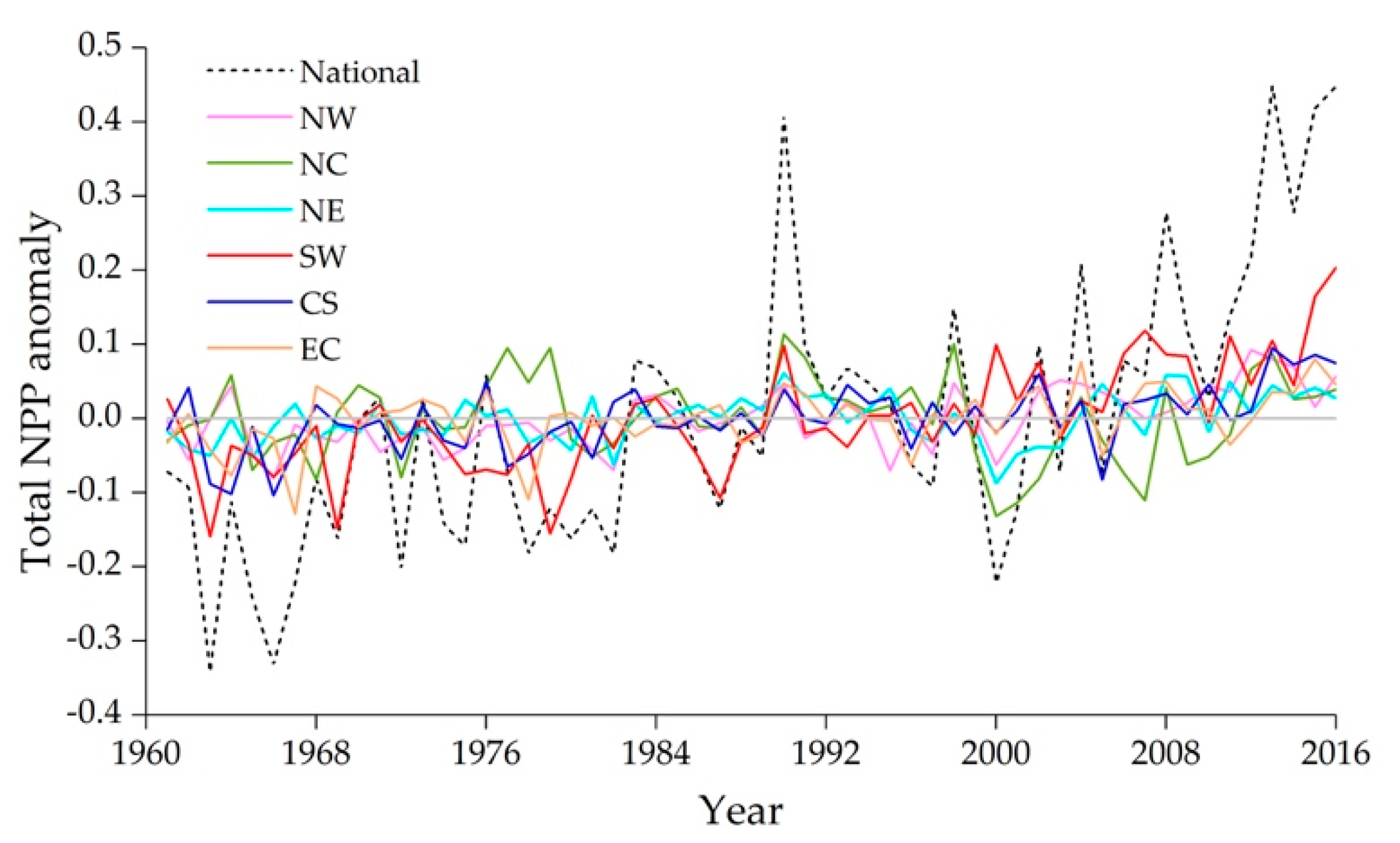
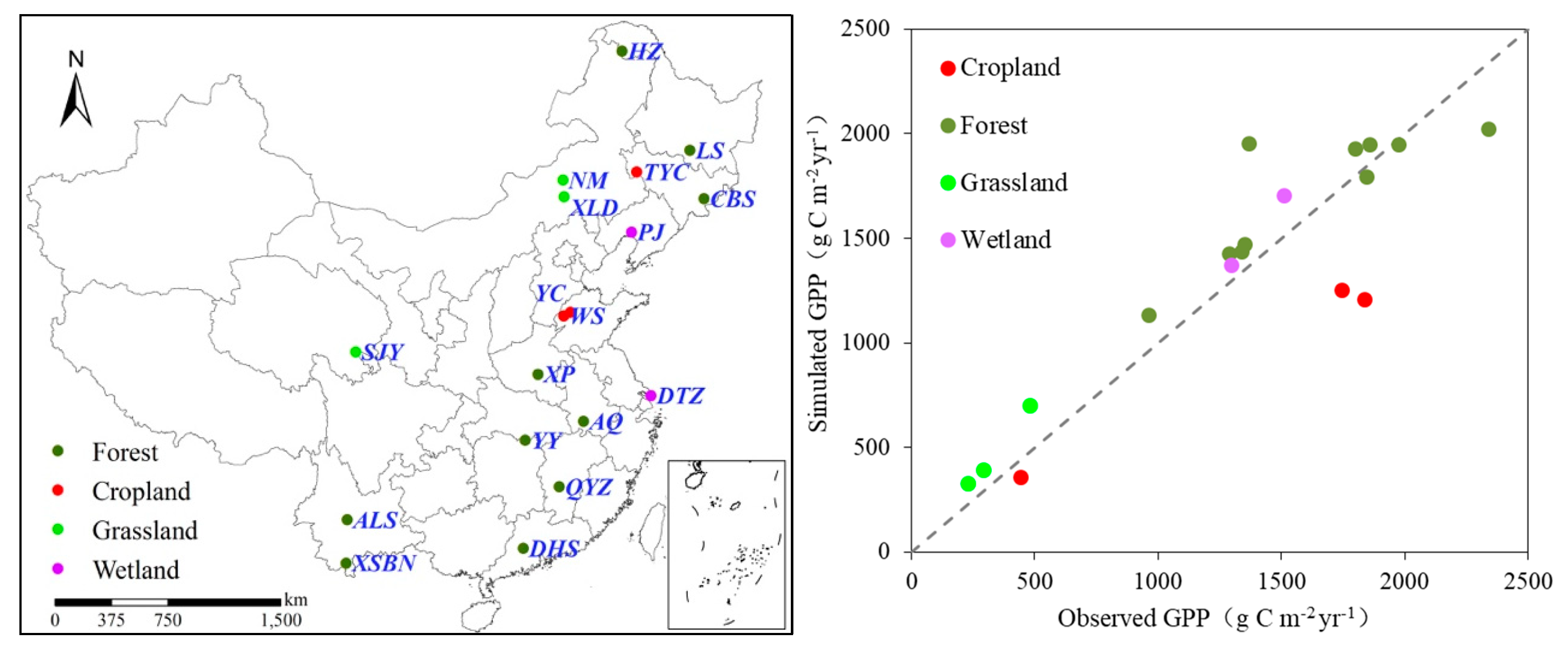



| NO | Scenarios | Projects | GCMs | SRES |
|---|---|---|---|---|
| 1 | CNRM-CM3-A2 | CMIP3 | CNRM-CM3 | AR4-A2 |
| 2 | CCSM3-A2 | CMIP3 | NCAR-CCSM3 | AR4-A2 |
| 3 | CNRM-CM3-B1 | CMIP3 | CNRM-CM3 | AR4-B1 |
| 4 | CCSM3-B1 | CMIP3 | NCAR-CCSM3 | AR4-B1 |
| 5 | CNRM-CM5-RCP45 | CMIP5 | CNRM-CM5 | AR5-RCP45 |
| 6 | CCSM4-RCP45 | CMIP5 | NCAR-CCSM4 | AR5-RCP45 |
| 7 | CNRM-CM5-RCP85 | CMIP5 | CNRM-CM5 | AR5-RCP85 |
| 8 | CCSM3-RCP85 | CMIP5 | NCAR-CCSM4 | AR5-RCP85 |
| Simulations | Scenario | History | Climate Change | CO2 Change |
|---|---|---|---|---|
| 1 | A2_CO2 | CRU | No | A2 |
| 2 | B1_CO2 | CRU | No | B1 |
| 3 | RCP45_CO2 | CRU | No | RCP45 |
| 4 | RCP85_CO2 | CRU | No | RCP85 |
| 5 | A2_C | CRU | A2 | No |
| 6 | B1_C | CRU | B1 | No |
| 7 | RCP45_C | CRU | RCP45 | No |
| 8 | RCP85_C | CRU | RCP85 | No |
| 9 | A2_Couple | CRU | A2 | A2 |
| 10 | B1_Couple | CRU | B1 | B1 |
| 11 | RCP45_Couple | CRU | RCP45 | RCP45 |
| 12 | RCP85_Couple | CRU | RCP85 | RCP85 |
| Model | Period | NPP (Pg C yr−1) | Reference |
|---|---|---|---|
| TEM4 | modern | 3.65 | [66] |
| LUE model | 1992–1993 | 2.65 | [17] |
| CASA | 1997 | 1.95 | [15] |
| CASA | 1982–1999 | 1.80 | [16] |
| CASA | 1982–1999 | 1.44 | [14] |
| CEVSA, GLO-PEN | 1981–1998 | 3.05 | [19] |
| CEVSA | 1981–1998 | 3.09 | [23] |
| LPJ | 1961–2000 | 4.64 | [20] |
| Remote Sensing model | 1989–1993 | 3.12 | [65] |
| BEPS | 2001 | 2.24 | [21] |
| CEVSA,CASA et al. | 1980–2005 | 2.86 | [67] |
| AVIM2 | 1981–2000 | 2.94 | [68] |
| LPJ | 1981–1998 | 3.11 | [69] |
| BEPS | 2000–2010 | 2.74 | [24] |
| CASA | 1980–2010 | 2.54 | [25] |
| Statistical model | 2000–2010 | 3.89 | [13] |
| IBIS | 1960–2016 | 2.46 | [26] |
| CASA | 2015 | 2.93 | [18] |
| LPJ | 1961–2016 | 3.10 | This Study |
| Code | Types | Latitude | Longitude | Period | GPPobs | LPJsim | RPE% |
|---|---|---|---|---|---|---|---|
| DHS | Forest | 23.17 | 112.53 | 2003–2008 | 1367.26 ± 78.42 | 1953.98 | 42.91% |
| QYZ | Forest | 26.73 | 115.05 | 2003–2008 | 1798.74 ± 100.44 | 1926.07 | 7.08% |
| CBS | Forest | 42.40 | 128.10 | 2003–2008 | 1338.84 ± 108.86 | 1437.48 | 7.37% |
| HZ | Forest | 51.78 | 123.02 | 2010 | 962.75 | 1133.02 | 17.69% |
| XSBN | Forest | 21.95 | 101.20 | 2003–2008 | 2342.67 ± 174.10 | 2020.26 | −13.76% |
| ALS | Forest | 24.53 | 101.02 | 2009–2010 | 1848.33 | 1791.98 | −3.05% |
| LS | Forest | 45.33 | 127.67 | 2004 | 1351 | 1472.64 | 9.00% |
| YY | Forest | 29.53 | 112.86 | 2006–2007 | 1974.8 | 1948.72 | −1.32% |
| AQ | Forest | 30.47 | 116.99 | 2006–2007 | 1859.2 | 1948.23 | 4.79% |
| XP | Forest | 33.35 | 113.91 | 2010 | 1288.1 | 1425.93 | 10.70% |
| YC | Cropland | 36.83 | 116.57 | 2003–2008 | 1746.62 ± 139.35 | 1250.08 | −28.43% |
| TYC | Cropland | 44.57 | 122.92 | 2004–2006 | 444.33 ± 56.36 | 356.00 | −19.88% |
| WS | Cropland | 36.65 | 116.05 | 2007–2008 | 1838 | 1208.18 | −34.27% |
| NM | Grassland | 44.53 | 116.67 | 2004–2008 | 231.66 ± 111.13 | 329.27 | 42.13% |
| XLD | Grassland | 43.55 | 116.67 | 2006 | 294.44 | 392.83 | 33.42% |
| SJY | Grassland | 34.35 | 100.55 | 2006 | 480.27 | 701.13 | 45.99% |
| DTZ | Wetland | 31.58 | 121.90 | 2005 | 1512.63 | 1704.31 | 12.67% |
| PJ | Wetland | 41.13 | 121.90 | 2005 | 1298.16 | 1371.52 | 5.65% |
| Periods | A2 | RCP85 | B1 | RCP45 | ||||
|---|---|---|---|---|---|---|---|---|
| NCAR | CNRM | NCAR | CNRM | NCAR | CNRM | NCAR | CNRM | |
| 2010s | 3.4 | 3.4 | 3.3 | 3.5 | 3.3 | 3.3 | 3.4 | 3.4 |
| 2020s | 3.7 | 3.4 | 3.6 | 3.7 | 3.4 | 3.4 | 3.4 | 3.5 |
| 2030s | 3.8 | 3.7 | 3.6 | 3.8 | 3.7 | 3.5 | 3.7 | 3.6 |
| 2040s | 3.9 | 3.8 | 3.7 | 4.0 | 4.0 | 3.8 | 3.8 | 3.9 |
| 2050s | 4.1 | 4.0 | 3.9 | 4.0 | 4.2 | 4.0 | 3.9 | 3.8 |
| 2060s | 4.5 | 4.2 | 3.9 | 3.9 | 4.5 | 4.1 | 4.0 | 4.1 |
| 2070s | 4.6 | 4.3 | 4.0 | 4.0 | 4.7 | 4.6 | 4.0 | 3.8 |
| 2080s | 4.9 | 4.6 | 3.9 | 4.2 | 4.9 | 4.9 | 4.0 | 4.1 |
| 2090s | 5.0 | 4.8 | 4.2 | 4.2 | 5.1 | 5.1 | 3.9 | 3.9 |
© 2019 by the authors. Licensee MDPI, Basel, Switzerland. This article is an open access article distributed under the terms and conditions of the Creative Commons Attribution (CC BY) license (http://creativecommons.org/licenses/by/4.0/).
Share and Cite
Huang, Q.; Ju, W.; Zhang, F.; Zhang, Q. Roles of Climate Change and Increasing CO2 in Driving Changes of Net Primary Productivity in China Simulated Using a Dynamic Global Vegetation Model. Sustainability 2019, 11, 4176. https://doi.org/10.3390/su11154176
Huang Q, Ju W, Zhang F, Zhang Q. Roles of Climate Change and Increasing CO2 in Driving Changes of Net Primary Productivity in China Simulated Using a Dynamic Global Vegetation Model. Sustainability. 2019; 11(15):4176. https://doi.org/10.3390/su11154176
Chicago/Turabian StyleHuang, Qing, Weimin Ju, Fangyi Zhang, and Qian Zhang. 2019. "Roles of Climate Change and Increasing CO2 in Driving Changes of Net Primary Productivity in China Simulated Using a Dynamic Global Vegetation Model" Sustainability 11, no. 15: 4176. https://doi.org/10.3390/su11154176
APA StyleHuang, Q., Ju, W., Zhang, F., & Zhang, Q. (2019). Roles of Climate Change and Increasing CO2 in Driving Changes of Net Primary Productivity in China Simulated Using a Dynamic Global Vegetation Model. Sustainability, 11(15), 4176. https://doi.org/10.3390/su11154176





